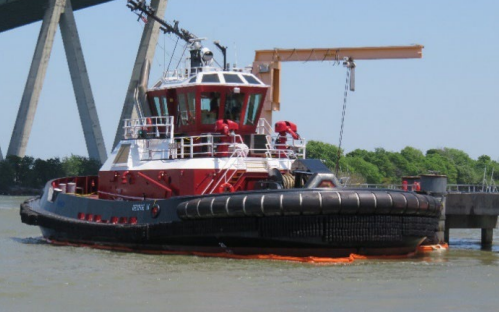Excessive speed during an advanced harbor-assist maneuver led to a tugboat colliding with a container ship in the Houston Ship Channel last year, the National Transportation Safety Board said recently.
The tugboat George M and container ship MSC Aquarius collided on April 14, 2022, while the tugboat was positioning for a ship-assist maneuver and the container ship was transiting north in the Houston Ship Channel. No injuries were reported.
About 1,000 gals. of gear oil were released from the damaged George M’s port propulsion unit. Damages to both vessels totaled more than $900,000.
The George M and another tugboat were performing a harbor-assist operation to dock the MSC Aquarius at the terminal.
The George M was assigned the “center lead forward” position on the bow of the container ship. To make up to the bow of the MSC Aquarius, the tugboat had to maneuver into position ahead of the container ship, bow-to-bow. The mate on the George M was operating the tugboat at the time of the collision. It was the mate’s first rotation on board the George M’s class of vessel.
In maneuvering the George M to the center forward position, the mate approached the container ship as it was transiting at 9.7 knots. While attempting to connect its line to the container ship, the tugboat moved out of centerline. The mate attempted to maneuver the tugboat back to the centerline but was unable to regain position. The mate’s attempt resulted in two collisions between the vessels.
The mate could have requested the pilot of the MSC Aquarius to slow, but the mate did not communicate with the pilot after being assigned to the center lead forward position. The pilot was unaware of the status of the tugboat or the need to slow.
The NTSB determined the probable cause of the collision was the George M mate’s attempt to make up bow-to-bow while the tugboat and container ship transited at a speed that was excessive for the advanced harbor-assist maneuver. Contributing to the collision was the George M mate’s lack of experience operating the tugboat.
“The risk of a casualty during bow-to-bow harbor-assist operations with azimuthing stern drive (ASD) tugboats increases with increasing speed. Hydrodynamic forces around an assisted vessel’s bow increase exponentially with speed, while the amount of reserve propulsion power available to the tugboat operator decreases,” the report said. “Owners and operators of ASD tugboats that perform bow-to-bow harbor-assist operations should set speed limits for these maneuvers. These limits may vary for different classes of tugboats based on design. Tugboat operators should communicate these pre-determined speed limits to ship masters or pilots in command of the vessels that they are assisting before engaging in these maneuvers.”





